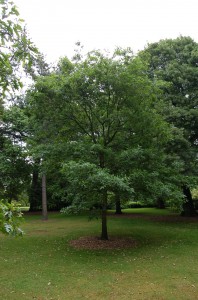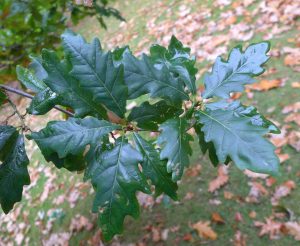Oak – Quercus petraea (Fagaceae)
Gaelic: darach
Common names: Sessile Oak, Durmast Oak
The sessile oak is native to Europe and Asia minor. It is the dominant tree of the Atlantic (west coast) woodlands in Scotland, these are temperate rainforests supporting a wide variety of species, including large numbers of lichens. They are long-lived and can grow in excess of 30m in height. The fruit is the familiar acorn, a cup supporting an elongated nut. It is one of two species of oak native to Britain, the other being the English oak Quercus robur, the two species can easily be distinguished by differences in their acorns; those of Q.petraea have a very short stalk, which has lead to the common name ‘sessile oak’, whereas acorns of Q. robur have longer stalks.
The wood of the oak is highly valued, as it is strong and durable. It is used for house building, furniture and boat building. The largest ship of the navy of King James IV, The Great Michael, was built near to Edinburgh in Newhaven, with the oak used harvested from the woodlands in Fife. Oak barrels are also key in the making of numerous types of alcohol including wine, beer and whisky as it imparts a particular flavour to the liquids stored within. The bark was used for tanning animal hides, and the collection and export of this to the tanneries of Glasgow was an import industry for communities in the Scottish Highlands. The timber was also used for firewood and charcoal and the sawdust was for smoking of meat and fish.
Oak has long been seen as one of the most magical trees and has an important place in the mythology of most northern European countries, representing power and strength. It was sacred to Druids (the priests of the Celts), whose staffs were made of oak branches and used it as part of celebrations of mid-winter and mid-summer solstices.



2 Comments
2 Pingbacks